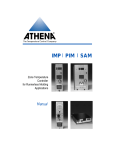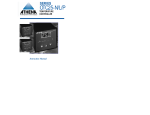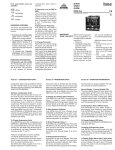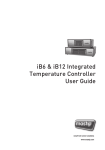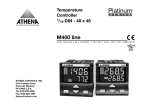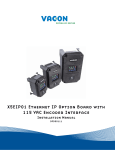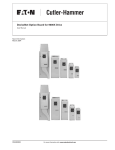Download Athena IMP Instruction manual
Transcript
SERIES IMP IMP/P SAM HOT RUNNER CONTROLLERS Instruction Manual Two-Year Limited Warranty THIS EQUIPMENT IS WARRANTED TO BE FREE FROM DEFECTS OF MATERIAL AND WORKMANSHIP. IT IS SOLD SUBJECT TO OUR MUTUAL AGREEMENT THAT THE LIABILITY OF THE MANUFACTURER IS TO REPLACE OR REPAIR THIS EQUIPMENT AT ITS FACTORY, PROVIDED THAT IT IS RETURNED WITH TRANSPORTATION PREPAID WITHIN TWO (2) YEARS OF ITS PURCHASE. THE PURCHASER AGREES THAT THE MANUFACTURER ASSUMES NO LIABILITY UNDER ANY CIRCUMSTANCES FOR CONSEQUENTIAL DAMAGES RESULTING FROM ITS USE OR FROM IMPROPER HANDLING OR PACKAGING OF SHIPMENTS RETURNED TO THE FACTORY. COMPONENTS WHICH WEAR OR WHICH ARE DAMAGED BY MISUSE ARE NOT WARRANTED. THESE INCLUDE CONTACT POINTS, FUSES, ELECTROMECHANICAL RELAYS, AND TRIACS. UNITS WHICH HAVE BEEN MODIFIED BY A CUSTOMER IN ANY WAY ARE NOT WARRANTED. Other than those expressly stated herein, THERE ARE NO OTHER WARRANTIES OF ANY KIND, EXPRESS OR IMPLIED, AND SPECIFICALLY EXCLUDED BUT NOT BY WAY OF LIMITATION, ARE THE IMPLIED WARRANTIES OF FITNESS FOR A PARTICULAR PURPOSE AND MERCHANTABILITY. IT IS UNDERSTOOD AND AGREED THE SELLER’S LIABILITY WHETHER IN CONTRACT, IN TORT, UNDER ANY WARRANTY, IN NEGLIGENCE OR OTHERWISE SHALL NOT EXCEED THE RETURN OF THE AMOUNT OF THE PURCHASE PRICE PAID BY THE PURCHASER AND UNDER NO CIRCUMSTANCES SHALL SELLER BE LIABLE FOR SPECIAL, INDIRECT, INCIDENTAL OR CONSEQUENTIAL DAMAGES. THE PRICE STATED FOR THE EQUIPMENT IS A CONSIDERATION IN LIMITING SELLER’S LIABILITY. NO ACTION, REGARDLESS OF FORM, ARISING OUT OF THE TRANSACTIONS OF THIS AGREEMENT MAY BE BROUGHT BY PURCHASER MORE THAN ONE YEAR AFTER THE CAUSE OF ACTION HAS ACCRUED. SELLER’S MAXIMUM LIABILITY SHALL NOT EXCEED AND BUYER’S REMEDY IS LIMITED TO EITHER (i) REPAIR OR REPLACEMENT OF THE DEFECTIVE PART OR PRODUCT, OR AT SELLER’S OPTION (ii) RETURN OF THE PRODUCT AND REFUND OF THE PURCHASE PRICE, AND SUCH REMEDY SHALL BE BUYER’S ENTIRE AND EXCLUSIVE REMEDY. THE SPECIFICATIONS PUT FORTH IN THIS MANUAL ARE SUBJECT TO CHANGE WITHOUT NOTICE. Athena Controls, Inc. 5145 Campus Drive Plymouth Meeting, PA 19462 Phone: 610-828-2490 Fax: 610-828-7084 www.athenacontrols.com You can reach our technical support team by phoning 1-800-782-6776 (from the United States) or 610-828-2490 (from anywhere in the world). The e-mail address for tech support is [email protected]. Athena® is a registered trademark of Athena Controls, Inc. © 2003 Athena Controls, Inc. All rights reserved. IMP I IMP/P I SAM Hot Runner Controllers Instruction Manual Table of Contents Section 1 1.1 1.2 1.3 Section 2 2.1 2.2 2.3 2.4 IMP I IMP/P Series General Description...................................... 3 Installation (IMP Series Only)....................... 4 Operation...................................................... 4 Model SAM Communications Module Installation.................................................... General Specifications.................................. Basic Operation............................................ Detailed Operation........................................ CompuStep™ and SafeChange™ are trademarks of Athena Controls, Inc. 12 13 15 15 IMP I IMP/P I SAM Hot Runner Controllers Instruction Manual IMP SERIES OPERATING INSTRUCTIONS ALARM/MODE DISPLAY DISPLAY ALARM SYMBOLS DOT INDICATORS POWER BEING DELIVERED TO LOAD OVER TEMPERATURE THERMOCOUPLE OPEN MANUAL MODE ON (DISPLAY INDICATES PERCENTAGE OF POWER) NO HEAT REMOTE AND STANDBY OPERATION % UNDER TEMPERATURE THERMOCOUPLE REVERSED DIGITAL SETPOINT SWITCH ACCURATELY SETS A SETPOINT TEMPERATURE TEMPERATURE AND PERCENTAGE POWER DISPLAY STANDBY (WARM) REGION PERCENTAGE POWER ADJUSTMENT KNOB CONTROLS PERCENTAGE OF POWER SUPPLIED TO LOAD IN MANUAL MODE SELECT TOGGLE SWITCH DISPLAY MODE SYMBOLS OPEN LOOP (MANUAL MODE) POWER SWITCH COMPUSTEP START-UP ON DURING FIVE MINUTE COMPUSTEP TIME PERIOD ON 0 CLOSED LOOP (AUTO MODE) OFF 1 IMP I IMP/P I SAM Hot Runner Controllers Instruction Manual IMP/P SERIES PORTABLE SINGLE ZONE HORIZONTAL CONTROLLER ALARM/DISPLAY DISPLAY ALARM SYMBOLS OVER TEMPERATURE UNDER TEMPERATURE DIGITAL SETPOINT SWITCH ACCURATELY SETS A SETPOINT TEMPERATURE THERMOCOUPLE OPEN NO HEAT THERMOCOUPLE REVERSED STANDBY (WARM) REGION TEMPERATURE AND PERCENTAGE POWER DISPLAY POWER SWITCH ON 0 OFF MODE SELECT TOGGLE SWITCH DISPLAY MODE SYMBOLS DOT INDICATORS OPEN LOOP (MANUAL MODE) POWER BEING DELIVERED TO LOAD CLOSED LOOP (AUTO MODE) % COMPUSTEP START-UP ON DURING FIVE MINUTE COMPUSTEP TIME PERIOD MANUAL MODE ON (DISPLAY INDICATES PERCENTAGE OF POWER) PERCENTAGE POWER ADJUSTMENT KNOB CONTROLS PERCENTAGE OF POWER SUPPLIED TO LOAD IN MANUAL 2 IMP I IMP/P I SAM Hot Runner Controllers Instruction Manual SECTION 1 OPERATING INSTRUCTIONS IMP Series 15 and 30 Amp Temperature Controllers IMP/P Series 10 and 15 Amp Temperature Controllers 1.1 General Description The IMP and IMP/P Series are microprocessor-based PID controllers specifically designed to perform most operator functions automatically. The IMP Series are plug-in units, while the IMP/P Series are portable, stand-alone instruments. Both are self-adjusting and capable of maintaining a very high degree of temperature accuracy over a wide range of operating conditions. Simplified controls and the use of status symbols allow the operator to make adjustments easily. The status display also provides visual indication of normal or abnormal operating conditions in both controller and load. All that is required of the operator is to set the temperature desired. From that point on, the controller will automatically perform all the operations required to achieve and maintain the selected temperature. Included in the design is a built-in safety feature that will automatically interrupt the controller output power when any thermocouple (T/C) fault is detected, when operating in closed-loop mode. In open-loop operation, the display shows percentage of power as set by the power control potentiometer (0-100%). The IMP plug-in controller is capable of receiving a standby command from the Standby Alarm Module (SAM) auxiliary module. When a standby or low heat command is acknowledged from the SAM during closed-loop operation, the controller will operate with a fixed setpoint. When receiving a standby command during open-loop operation, the output power of the controller will be reduced to 1/4 of the front panel power control setting. 3 IMP I IMP/P I SAM Hot Runner Controllers Instruction Manual The IMP controller also sends alarm status conditions to the SAM auxiliary module for annunciation and remote control functions. 1.2 Installation (IMP Series Only) All IMP Series controllers are ready to use as shipped from the factory. Prior to installation into a mainframe, make sure the voltage, Hz, and degree options are as ordered and correspond to the Product ID label. CAUTION Never insert or remove a controller from a mainframe with the AC power on. Hazardous potentials exist on components inside the mainframe and controller. Always disconnect AC power to the mainframe when servicing. To install a plug-in controller into a mainframe, release the locking device on the lower edge of the unit by pulling the plunger gently away from the panel. Align the upper and lower edges of the printed circuit board on the controller with the mainframe card guide slot and slide in until the rear connector is completely engaged. Lock the controller into the frame by depressing the plunger on the locking device. 1.3 Operation Note: Any flashing display indicates that the controller has detected a fault. Refer to section on Faults. Automatic Closed-Loop Operation 1. Position Mode select switch to closed-loop (“O”). 2. Set temperature on Setpoint switch. 3. Turn on AC power. 4. After a short reset delay, the measured temperature will be displayed. If the temperature is 30 ºF (17 °C) or more below setpoint, the under temperature alarm display (lower segment of the leftmost digit) will flash. If the temperature 4 IMP I IMP/P I SAM Hot Runner Controllers Instruction Manual is 30 ºF (17 °C) or more above setpoint, the over temperature alarm display (upper segment of the leftmost digit) will flash. During alarm conditions, temperature display will also flash. If the temperature is within alarm limits, the display will stop flashing, and the leftmost digit will display closed-loop mode (“ ”). 5. Power to load indicator (the decimal point of the leftmost digit) will be on if any power is being applied to the load. 6. When any of the T/C faults are detected, output power will be cut off automatically and the temperature display will be blanked out. The leftmost digit will show “ ” for (T/C open), “ ” for (T/C reverse) or “ ” for No Heat and flash twice per second. Automatic Operation with CompuStep system When starting from cold, it is recommended that the CompuStep system be used to lengthen heater life considerably. 1. 2. 3. 4. Position the mode select switch to CompuStep mode (“ ”). Set the desired temperature on the setpoint switch. Turn on the AC power. After reset delay, the measured temperature will be displayed. If temperature is less than 200 ºF (93°C) the controller will enter the CompuStep mode. This is indicated by the step symbol “ ” on the leftmost digit. During this mode, the controller gradually increases power to load in small steps. After 5 minutes or when the temperature reaches 256 ºF (124 °C), the controller will exit from CompuStep mode and automatically go to setpoint. Any thermocouple faults detected during the 5-minute interval will cause the CompuStep mode to end prematurely. A standby command from a SAM module will also terminate CompuStep mode. When CompuStep ends, the controller will operate as described in the Automatic Closed-Loop Operation section. If temperature is above 200 ºF (93°C), controller will bypass CompuStep and go directly to setpoint. 5 IMP I IMP/P I SAM Hot Runner Controllers Instruction Manual Manual Open-Loop Operation 1. Position the mode select switch to open-loop (“ ”). 2. Turn the AC power on. 3. After reset delay, the controller will display the percentage of output power as adjusted by the power control knob. The percentage power indicator will be on. Thus 0.00 corresponds to 0% (no power) and 1.00 corresponds to 100% (full power). The leftmost digit will display open-loop mode (“ ”). 75% power is shown as 0.75. Manual Control Pre-Set The following procedure can be used to pre-set the Manual Power Control Knob position in the event of a thermocouple break in closedloop operation. A good thermocouple is required to start with, as this procedure compares the temperature attained using automatic (closed-loop) control with that obtained using manual (open-loop) control. When the temperature is the same using either automatic or manual control, then the position of the Manual Power Control Knob is correct. Procedure for Manual Control Pre-Set a. Adjust controller for closed-loop operation and obtain good molded parts. This will adjust the controller to the proper temperature. b. Position the module select switch to open-loop and set the manual control knob to roughly 25%. Wait for 10 seconds, than momentarily switch to closed-loop mode to examine the temperature. If it is above the setpoint, the manual power is too high to maintain proper temperature. If it is below setpoint, the manual power is too low. Adjust the power control knob accordingly, wait for 10 seconds, then re-examine the temperature by switching momentarily to closed-loop mode. Repeat this procedure until the temperature is the same in either automatic or manual control. 6 IMP I IMP/P I SAM Hot Runner Controllers Instruction Manual Standby Heat (SAM module only) Standby heat is a low heat level used to keep heaters and associated equipment warm. Its purpose is to prevent moisture build-up in heaters and equipment during idle periods and to provide fast startup when returning to normal operations. When using a SAM, activate the standby switch. The SAM will send a standby command to all controllers. A controller, upon receiving the command, will respond accordingly to its present mode of operation: a. If the controller is in closed-loop mode, the setpoint becomes 200 ºF (93 ºC) regardless of the set point switch setting. The Remote Standby Indicator (the decimal of the last digit) will be on, indicating that the remote standby function is active. b. If the controller is in open-loop mode, the power out put is reduced to 1/4 of the value adjusted by the power control knob. Notice that the % power display will show the reduced value. The remote standby indicator will be on. Faults 1. Over temperature alarm: A constant over temperature alarm is most likely caused by a shorted triac in the controller or incorrect or shorted mold wiring. Switch module power off as quickly as possible and replace controller or correct wiring error. Check for thermocouple or heater cross wiring. 2. Under temperature alarm: Under temperature alarm is normal during system start- up before the setpoint is reached. If under temperature persists, a No heat fault will occur. 3. Thermocouple open or reversed: If any T/C fault is detected during closed-loop operation, the output power will be cut off. If it is necessary to apply power to the load during a T/C fault condition, the controller can be 7 IMP I IMP/P I SAM Hot Runner Controllers Instruction Manual switched to manual mode. The output power will be a function of the manual control knob setting. Since the controller is now operating in open-loop mode, extreme care must be taken when adjusting to prevent excess output power that would overheat the load. 4. No heat: The IMP series controller has included in its microprocessor a program that detects that the temperature is not rising as it should in response to full power output. “No heat” is defined as the condition under which the temperature does not increase more than 2 ºF during a 60-second interval during start-up. It takes 60 seconds to detect “No heat” when power is first turned on in closed-loop mode. If CompuStep is active, the test is not performed until after CompuStep is finished (5 minutes). When “No heat” alarm is detected, output power is cut off. What to do: a. Try resetting the controller by turning its AC power OFF and then ON. b. If “No Heat” persists, then the problem could be one of the following. 1) Open heater or load. 2) Thermocouple shorted. Switch to manual mode to override this condition. 3) Load circuit open. This can be caused by an open power cable, an open connector or a failed triac in the controller. Exchange the module with a known good module to eliminate suspect triac or module. 4) Slow heater. Use higher power heater or operate in manual mode until setpoint is achieved. 5) Thermocouple too far away from heat source that causes less than 2 ºF (1 ºC) rise in 60 seconds due to thermal lag. Move thermocouple as close to heater as possible or use heater with built in thermocouple. 6) To defeat “No Heat” circuit, if not used or required, remove jumper J4 and that circuit will no longer be active. 8 IMP I IMP/P I SAM Hot Runner Controllers Instruction Manual User’s Selected Jumper Option 1. For degree Celsius operation, install jumper on PC board marked J1 (marked C on newer models) 2. For 50 Hz operation, install jumper on PC board marked J2 (automatic on units built after 1999) 3. For 120 Vac input operation, install the 2 jumpers on the PC board as shown. 4. For 240 Vac input operation, install the 1 jumper on the PC board as shown. Note: If units are factory wired for 240 Vac, remove 240 V jumper prior to installing a 120 V jumper. SafeChange hot swap feature Controllers are shipped with SafeChange disabled, because the controller will not work if the SafeChange feature is enabled, but the mainframe does not support SafeChange. You can enable SafeChange quickly and easily using a jumper as described in this section. Basic set up choices are made using DIP switches as described in this section. The switches in a Series IMP Hot Runner controller are set at the factory for J thermocouple as the input type, with Fahrenheit as the unit of measure for North America, and Celsius for other shipping destinations. 1. Checking Mainframe for SafeChange Capability Do not enable SafeChange unless the mainframe supports this feature. To check the mainframe for SafeChange capability: a. Turn off power to the mainframe. b. Remove a blanking panel or a controller that is OFF, so you can look into the mainframe. c. Look at the lower connector block on the backplane. 1) If a metal clip is in the third position in the connector block, then the mainframe supports 9 IMP I IMP/P I SAM Hot Runner Controllers Instruction Manual SafeChange. SafeChange should be enabled on the controller before installing it in the mainframe to reduce the possibility of damage to the controller. Use of the SafeChange feature does not eliminate the need for careful installation and removal of controllers. Always turn off power to the controller and the mainframe when installing or removing a controller. 2) If the third position in the connector block does not contain a metal clip, then the mainframe does not support SafeChange. You can add a clip to convert Location of Clip in Mainframe the mainframe. to Support SafeChange 3. Enabling the SafeChange Feature Controllers are shipped with SafeChange disabled, because the controller will not work if the SafeChange feature is enabled, but the mainframe does not support SafeChange. You can enable SafeChange quickly and easily. To enable the SafeChange feature, remove the jumper block from JP6. Location of SafeChange Jumper JP6 10 IMP I IMP/P I SAM Hot Runner Controllers Instruction Manual If you don’t see JP6, the controller in hand may pre-date the SafeChange feature. In addition to JP6 in the location shown above, controllers that support SafeChange also have one edge connector shorter than the others. If all the edge connectors are the same length, the controller does not support the SafeChange feature. SafeChange Edge Connector 4. Adding a SafeChange Clip to the Mainframe You can convert an older mainframe to support SafeChange. To make the conversion, you must add a clip to the third position in the lower connector block (on the backplane) in every slot; see the illustration. The clip is p/n 216D001U01. To install the clip: a. Turn off power to the mainframe. b. Remove the back cover of the mainframe. c. Position the clip in the third (open) position in the lower connector block, and press. The clip will snap into position. 11 IMP I IMP/P I SAM Hot Runner Controllers Instruction Manual SECTION 2 OPERATING INSTRUCTIONS Model SAM Communications Module 2.1 Installation CAUTION Never insert or remove the module from a mainframe with the AC power on. Always switch the module or mainframe to OFF. Hazardous potentials exist on components inside both the module and mainframe. Always disconnect the AC power to the mainframe when servicing. SAM must be used in conjunction with a model “MFC” communications-type mainframe, and one or more IMP series microprocessor-based temperature controllers. It is shipped from the factory ready to use. No special preparation is required. Installation Procedure: 1. Carefully unpack module. SAM may be plugged into any unused zone of the mainframe.* 2. Release locking device by gently pulling push-pull fastener away from the front panel. 3. Line up module printed circuit board with respective mainframe guides. Insert module firmly, making sure rear connectors are fully engaged. 4. Lock module into place by depressing push-pull fastener. *Note: SAM will work in any mainframe zone. A heater connected to a zone with a SAM inserted will not affect operation of the module. 12 IMP I IMP/P I SAM Hot Runner Controllers Instruction Manual 2.2 General Specifications Standby Temperature 200 ºF (93 ºC) AC Input Requirements 240 Vac +10% -20%, 48-63 Hz (standard)120 Vac (available) Alarm Limits ± 30 ºF (17 ºC) when used with an IMP Alarm Output (Audible) Over Temperature: 2 KHz tone at 2 Hz interval Under Temperature: 1 KHz tone at 1 Hz interval Alarm Output (Visual) Over Temperature: 2 Hz flashing rate Under Temperature: 1 Hz flashing rate Output Connector AMP MIL-style connector (4 Pin) providing Normally Closed and Normally Opened relay contacts. (5 amps maximum) Communication Capacity 50 zones maximum 13 IMP I IMP/P I SAM Hot Runner Controllers Instruction Manual SAM MODULE QUICK REFERENCE GUIDE SPEAKER FAST, HIGH TONE = OVER TEMPERATURE 30°F (17°C) OR MORE ABOVE SETPOINT SLOW, LOW TONE = UNDER TEMPERATURE 30°F (17°C) OR MORE BELOW SETPOINT LOW TEMP ALARM MODE SWITCH LOW TEMP ALARM MODE INHIBIT LOW TEMP ALARM ACTIVE EXTERNAL OUTPUT CONNECTOR PINS 1 & 2 - N.C. RELAY CONTACTS OVER TEMP. LED (red) UNDER TEMP. LED (red) PINS 1 & 3 - N.O. RELAY CONTACTS STANDBY LED (yellow) STANDBY ON-OFF SWITCH POWER ON LED DAY USE OR NORMAL NIGHT USE OR STANDBY (YELLOW STANDBY LED ILLUMINATES) POWER SWITCH ON OFF LOCKING DEVICE 14 IMP I IMP/P I SAM Hot Runner Controllers Instruction Manual 2.3 Basic Operation 1. Select Normal or Standby Mode. 2. Select Low Temperature Alarm Mode. a. Low Temperature Alarm Inhibit : Speaker will be off and output relay inactive in the event of low temperature condition (useful during start-up procedures). b. Low Temperature Alarm Active : 30 °F (17 °C) or more below IMP setpoint temperature will sound alarm and energize output relay contacts. 3. Turn Power On-Off Switch to “ON” position. 4. Alarm indications are automatic. (See detailed operation.) 2.4 Detailed Operation 1. Normal or Standby Operation a. Normal : In this mode the standby feature is defeated and temperature control is in accordance with the IMP controller(s) settings. b. Standby : With the toggle switch in this position, the standby mode is engaged. This will set the temperature of all IMP controllers operating in automatic mode to a standby temperature of 200 ºF (93 ºC). 1) Any IMP controller operating in manual mode will have its output power level reduced to 1/4 of its present level. 2) When SAM and IMP controller(s) are in use at normal operating temperature [setpoint above 230 ºF (119 ºC)], switching to standby mode will result in an over temperature alarm until all zones cool down to below 230 ºF (110 ºC). 2. Alarm Indications: When an over temperature or under temperature condition exists in any zone occupied by an IMP controller, both audio (tones) and visual (LED) alarms will occur in the SAM. a. Over Temp. : Occurs when an IMP thermocouple is 30 ºF (17 ºC) or more above setpoint. The speaker will emit a high-pitched audio tone of about 2 KHz repeating about twice per second. At the same time, 15 IMP I IMP/P I SAM Hot Runner Controllers Instruction Manual the over temperature LED will flash, and relay closure will occur. b. Under Temp. : Occurs when an IMP-15 thermocouple is 30 ºF (17 ºC) or more below setpoint. The speaker will emit a low-pitched audio tone of about 1 KHz repeating about once per second. At the same time, the under temperature LED will flash, and relay closure will occur. c. Over Temp. Alarm Priority: If an over temperature and under temperature condition exists simultaneously from more than one IMP controller, SAM will indicate only the over temperature condition. SAM will not recognize any under temperature condition, until all over temperature alarms have been cleared. 3. Front Panel Output Connector: A set of relay contacts is available at this connector for use with external equipment if desired. Observe the 5 amp maximum contact rating. Pins 1 and 2 have Normally Closed contacts. Pins 1 and 3 have Normally Open contacts. a. During either an over temperature or under temperature alarm condition, the relay will be energized. b. Relay operation is defeated when the Low Temperature Alarm mode switch is in the Inhibit ( ) position. (This will be clarified in the next section.) 4. Low Temperature Alarm Mode Switch: This switch gives the operator the ability to defeat both the low temperature audio alarm and output connector relay operation. This feature is useful to avoid sounding an alarm during startup or cooling down procedures. The under temperature LED is unaffected by this switch. All over temperature alarm indications are also unaffected by this switch. a. Low Temp. Alarm Active : In this position, under temperature alarm indications operate normally. b. Low Temp. Alarm Inhibit : In this position, an under temperature condition of 30 ºF (17 ºC) or more below setpoint will not sound the audio alarm. Also, the output connector relay will not be energized. The under temperature LED is unaffected, and will flash as usual. 16 IMP I IMP/P I SAM Hot Runner Controllers Instruction Manual 5. Remote Standby Option: It is possible to wire the mainframe for remote standby operation as outlined in the following procedure. a. Locate the appropriate communications connector for the zone to be occupied by the SAM. This is on the upper strip of connectors on the rear of the model “MFC” mainframe. b. Carefully wire an isolated set of Normally Open relay contacts, rated at 5 volts and 1/2 amp, to Pins 8 and 12 of the mainframe connector. Note that this relay is not included. c. When the remote relay is energized, SAM will be placed in the Standby mode of operation. d. A SAM must be installed for this option to work. 17 IMP I IMP/P I SAM Hot Runner Controllers Instruction Manual NOTES 18 IMP I IMP/P I SAM Hot Runner Controllers Instruction Manual SERIES IMP/P WIRING & CONNECTION DIAGRAM (FEMALE) (MALE) v v MOLD CABLE END CKPTM1 v CABLE END CKPTF1 v CABLE MPT/C10 (10 FOOT) MPT/C20 (20 FOOT) MAINFRAME CONNECTOR CKPTOC1 MOLD CONNECTOR CKPTIC1 POWER OUT AND THERMOCOUPLE IMP/P 15B NEMA IN, 5 PIN OUT CKPTM1 IMP/P 15A NEMA IN, NEMA OUT POWER IN AC2024F OUTPUT AC INPUT OUTPUT FEMALE PLUG THERMOCOUPLE INPUT 19 POWER OUT THERMOCOUPLE AC1524M M2MJ AC INPUT MALE PLUG MALE PLUG IMP I IMP/P I SAM Hot Runner Controllers Instruction Manual SERIES IMP/P WIRING & CONNECTION DIAGRAM IMP/P 10B POWER CORD IN, 5 PIN OUT AC INPUT OUTPUT 20 For technical assistance, call toll free 1-800-782-6776 (in the U.S.) or 610-828-2490 (from anywhere in the world), or e-mail [email protected]. The Temperature Control Company 900M001U01RevC-0803-1.5M-JA Athena Controls, Inc. 5145 Campus Drive Plymouth Meeting, PA 19462 USA Toll-free: 800.782.6776 Tel: 610.828.2490 Fax: 610.828.7084 [email protected] athenacontrols.com

























